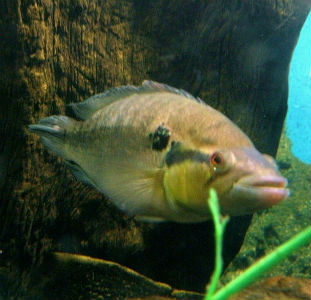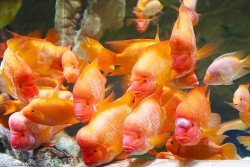Crenicichla lepidota the Two Spot Pike cichlid from South America
 Crenicichla lepidota, commonly known as the Spotted Pike Cichlid or Lepidota Pike Cichlid, is a captivating and distinctive member of the Cichlidae family. Native to the waters of South America, particularly the Amazon River basin, this species is recognized for its unique combination of striking physical features and intriguing behavior.
Crenicichla lepidota, commonly known as the Spotted Pike Cichlid or Lepidota Pike Cichlid, is a captivating and distinctive member of the Cichlidae family. Native to the waters of South America, particularly the Amazon River basin, this species is recognized for its unique combination of striking physical features and intriguing behavior.From its vividly marked appearance to its territorial tendencies, Crenicichla lepidota has earned its place as a sought-after species among aquarium enthusiasts. In this exploration, we delve into the fascinating world of C. lepidota, uncovering its characteristics, care requirements, and the allure that makes it a remarkable addition to aquariums worldwide.
Common Names
Crenicichla lepidota, commonly known as the Spotted Pike Cichlid or Lepidota Pike Cichlid, is recognized by these names among aquarium enthusiasts.Etymology
The specific name "lepidota" in Crenicichla lepidota likely refers to its characteristic spotted or scaled appearance, as "lepidota" can be translated to "scaled" or "spotted" in Greek.Classification
Crenicichla lepidota belongs to the Cichlidae family, which encompasses a diverse group of cichlids. Within this family, Crenicichla is a genus of pike cichlids, and C. lepidota is a species known for its distinctive features.Distribution
C. lepidota is primarily found in South America, specifically in regions of the Amazon River basin, where it inhabits various water systems, including rivers and tributaries.Habitat
In its natural habitat, Crenicichla lepidota often resides in areas with rocky substrates and submerged structures, where it can seek shelter and ambush prey.Maximum Standard Length
The maximum standard length for Crenicichla lepidota typically ranges between 6 to 8 inches (15 to 20 cm) when mature.Aquarium Size
To provide ample space for C. lepidota, an aquarium with a minimum size of 55 gallons is recommended. This allows for swimming space and the inclusion of appropriate hiding spots.Maintenance
Maintaining C. lepidota in captivity involves providing a well-structured tank with hiding places, rocks, and caves to mimic its natural habitat. Regular water changes and efficient filtration are essential for its well-being.Water Conditions
C. lepidota thrives in slightly acidic to neutral water conditions with a pH range of 6.0 to 7.5 and a temperature range of 75-82°F (24-28°C).Diet
Crenicichla lepidota is a carnivorous species, and its diet should primarily consist of high-quality pellets, live or frozen foods like small fish, shrimp, and earthworms. Offering a varied diet enhances its health and vitality. Juveniles prefer live fish, blood worms, glass worms, brine shrimp and tubifex worms. Frozen plankton, beef heart, brine shrimp, glass worms and blood worms. Freeze dried foods also accepted. Adults will usually only eat live fish.Behaviour and Compatibility
C. lepidota is known for its territorial and aggressive nature, especially during the breeding season. It is best kept in a species-specific aquarium or with robust tankmates that can withstand its behavior.Sexual Dimorphism
Sexual dimorphism in Crenicichla lepidota is challenging to discern based on physical characteristics alone. Males may exhibit slightly brighter colors or larger size, but these differences can be subtle.Reproduction
Breeding C. lepidota can be a complex endeavor, as they are known for their territoriality and aggression. Successful breeding may require a dedicated breeding pair in a spacious tank with suitable spawning sites.Endangered List
Crenicichla lepidota is not commonly listed as an endangered species, but it is essential to maintain healthy populations through responsible aquarium husbandry and breeding practices.





